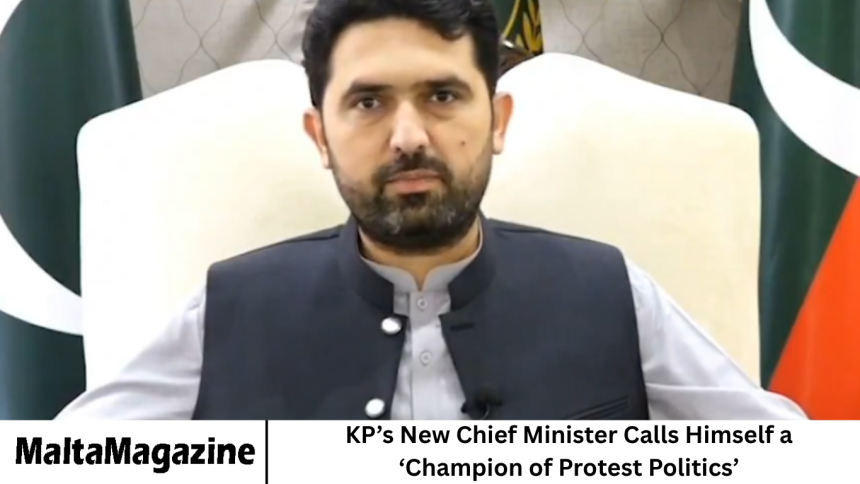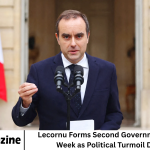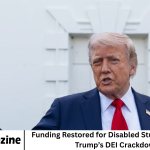Khyber Pakhtunkhwa (KP) has long been a province marked by vibrant politics, grassroots activism, and shifting alliances. The emergence of the new Chief Minister has reignited debates about protest-driven governance and the meaning of people’s power in a changing Pakistan.
- The Rise of KP’s New Chief Minister
- Defining ‘Protest Politics’ in Pakistan
- The Political Context: KP After the 2024 Elections
- Public Response: Supporters vs. Critics
- From Protest to Policy: The Challenge of Transition
- Governance Priorities and Early Moves
- Economic and Security Landscape
- Federal-Provincial Relations: A Test of Cooperation
- Media and Public Discourse
- Historical Perspective: KP’s Legacy of Activism
- The Road Ahead: Expectations vs. Reality
- Frequently Asked Question
- Conclusion
Soon after taking oath, the newly appointed KP Chief Minister declared himself a “champion of protest politics,” signaling a continuation of the combative, street-oriented style that has defined much of Pakistan’s recent political history.
This statement, delivered amid a wave of anticipation, has sparked widespread reaction. Supporters hail it as a bold reaffirmation of democratic expression and accountability. Critics, however, warn that “protest politics” could deepen instability in a province already navigating complex economic.
More Read: Macron Blames Rivals as France’s Political Turmoil Deepens
The Rise of KP’s New Chief Minister
The new Chief Minister’s journey to the top reflects the shifting dynamics within KP’s power structure. Coming from a strong political background within his party — most likely the Pakistan Tehreek-e-Insaf (PTI) or its aligned faction — he has built his image as a loyal follower of his party’s central leadership.
Over the years, he has participated in major national protests, sit-ins, and rallies that challenged federal authority, calling for electoral reforms, transparency, and people’s empowerment.
He represents a generation of politicians shaped by public mobilization rather than traditional patronage networks. His roots are deeply tied to the protest culture that gained momentum during Imran Khan’s political ascent — a movement that blurred the lines between activism and governance.
When he declared himself a “champion of protest politics,” he was not just staking a personal claim but also signaling a return to his political roots — where public resistance and reformist rhetoric are central to leadership identity.
Defining ‘Protest Politics’ in Pakistan
“Protest politics” has long been a defining feature of Pakistan’s democracy. From the lawyers’ movement of 2007 to the PTI’s long marches and dharnas, it has often served as a vehicle for both reform and political pressure.
In the KP Chief Minister’s case, the label “champion of protest politics” carries layered meaning:
- A continuation of his party’s tradition — mobilizing people against perceived injustices.
- A reminder of accountability — a commitment to challenge any form of corruption or misrule.
- A warning to opponents — that governance will not silence activism.
However, this raises an important question: can protest politics coexist with the responsibility of governing a province?
While the Chief Minister’s rhetoric appeals to the masses, it also highlights the challenge of transforming protest energy into effective policy. Running a province requires negotiation, compromise, and administrative consistency — qualities not always aligned with the combative tone of street protests.
The Political Context: KP After the 2024 Elections
Following the 2024 general elections, Khyber Pakhtunkhwa once again emerged as a stronghold for PTI-affiliated candidates, despite the party’s organizational struggles at the national level. The public’s continued loyalty to PTI’s message of accountability and reform has kept the province politically charged.
The new Chief Minister assumed office amid growing pressure from both federal authorities and opposition groups within the provincial assembly. His government faces multiple challenges:
- Economic instability: Limited provincial revenues and dependency on federal transfers.
- Security concerns: Resurgence of militant activity in certain regions.
- Governance gaps: Public frustration over education, healthcare, and infrastructure.
- Political polarization: Tensions between pro-PTI elements and the federal coalition.
Against this backdrop, his embrace of “protest politics” can be seen as a strategic move — reaffirming loyalty to PTI’s ideological base while signaling defiance against the federal government’s policies.
Public Response: Supporters vs. Critics
The Chief Minister’s remarks have drawn mixed reactions across the political spectrum.
Supporters’ View
Supporters see his stance as a declaration of independence and courage. To them, protest politics represents the voice of ordinary Pakistanis, especially those who feel sidelined by the traditional elite. They believe his leadership will continue the struggle for justice, fair governance, and provincial rights.
Many young voters in KP view protests not as disruptions but as symbols of resistance against corruption and central dominance. Social media platforms flooded with praise, framing him as a leader who stands with the people rather than the bureaucracy.
Critics’ Concerns
On the other hand, critics argue that the province needs stability, not slogans. They warn that continuous political confrontation could hurt development projects and delay crucial policy decisions. Bureaucratic morale could suffer if governance becomes too politicized.
Opposition leaders accuse the new Chief Minister of prioritizing political theatre over practical governance. They emphasize that KP’s people deserve jobs, education, and peace — not constant agitation.
From Protest to Policy: The Challenge of Transition
Running a province is vastly different from leading a march. The Chief Minister now faces the test of converting protest promises into policy performance.
Key questions loom large:
- Can he deliver administrative efficiency while maintaining his activist image?
- Will he work with the federal government despite political differences?
- How will he handle security and economic crises while promoting protest ideals?
Observers point out that the Chief Minister must balance dual responsibilities: keeping the political base energized while ensuring governance continuity. This balancing act will determine whether he can emerge as a true reformer or remain confined to the rhetoric of resistance.
Governance Priorities and Early Moves
Since assuming office, the Chief Minister has made several early moves to signal his agenda:
- Accountability Drive: Announced renewed investigations into alleged corruption in provincial departments.
- Youth Engagement: Promised job creation and entrepreneurship programs to address unemployment.
- Public Participation: Encouraged town hall-style meetings across districts to hear citizens directly.
- Provincial Autonomy: Reiterated KP’s right to greater fiscal independence from the federal center.
- Administrative Reform: Ordered audits of key development projects for transparency.
These steps, while symbolically strong, will need careful execution to produce tangible outcomes. Governance experts caution that without clear implementation frameworks, such announcements may risk being seen as political posturing.
Economic and Security Landscape
The economic situation in KP remains fragile. Inflation, limited industrial growth, and reduced investment have hindered development. Tourism — once a bright spot — has suffered due to regional instability.
Moreover, the re-emergence of militant threats in certain tribal districts adds pressure on law enforcement and governance. The Chief Minister’s emphasis on protest politics may resonate emotionally, but sustaining peace and development will require coordination with federal security agencies — a challenge amid political friction.
Economic analysts argue that KP must diversify its economy through industrial zones, agriculture modernization, and cross-border trade facilitation with Afghanistan. Any long-term success depends on consistent policy, not protests alone.
Federal-Provincial Relations: A Test of Cooperation
The relationship between KP’s new leadership and the federal government remains tense. The Chief Minister’s declaration positions him as a political challenger to Islamabad’s authority. However, cooperation between the two levels of government is vital for funding, security coordination, and infrastructure development.
Political analysts note that KP’s leaders often walk a fine line between defending provincial rights and maintaining constructive engagement with the center. If the Chief Minister leans too heavily on confrontational rhetoric, it could strain financial negotiations or delay essential development schemes.
Still, many within his party view confrontation as necessary to assert provincial autonomy and expose what they describe as “unjust treatment” from the federal government.
Media and Public Discourse
The Chief Minister’s remarks have dominated media coverage, sparking debates on television panels, talk shows, and online forums. Some journalists describe him as “a street politician in a Chief Minister’s chair,” while others call him “the embodiment of people’s resistance.”
Editorials across major publications question whether KP can afford continuous confrontation. Yet, among his supporters, the phrase “champion of protest politics” has become a badge of honor — a rallying cry for political empowerment in a region that often feels ignored by Islamabad.
Social media hashtags praising his statement trended nationwide, showing how populist messages continue to shape Pakistan’s political narrative.
Historical Perspective: KP’s Legacy of Activism
Khyber Pakhtunkhwa’s political history has always been intertwined with activism and resistance. From the Khilafat Movement to the anti-colonial struggles led by figures like Khan Abdul Ghaffar Khan (Bacha Khan), the province has a rich legacy of political consciousness.
The PTI-era protests that swept through Islamabad in 2014 and 2022 drew significant participation from KP citizens, reinforcing the province’s identity as a hub of political energy.
The new Chief Minister’s self-identification as a protest leader aligns with this historical tradition — portraying protest not as chaos, but as a continuation of a long-standing culture of dissent.
The Road Ahead: Expectations vs. Reality
As the Chief Minister settles into office, expectations are running high. People want action on promises, not just speeches. The province demands job creation, improved education, efficient health care, and infrastructure revival.
Balancing these expectations while maintaining his activist appeal will be a defining challenge. Analysts predict that his success will depend on three factors:
- Administrative Strength: Ability to appoint competent bureaucrats and ensure good governance.
- Political Strategy: Managing relations with the federal government without alienating voters.
- Public Perception: Keeping the protest narrative alive without letting it overshadow real progress.
If managed wisely, the Chief Minister could set a new precedent — showing that protest-driven leaders can transition into effective policymakers. If not, KP may face prolonged political turbulence.
Frequently Asked Question
Who is the new Chief Minister of Khyber Pakhtunkhwa (KP)?
The new Chief Minister is a prominent figure from the Pakistan Tehreek-e-Insaf (PTI) political movement, known for his active participation in protests and reform campaigns. His rise represents continuity of PTI’s influence in the province after the 2024 elections.
What does he mean by being a “champion of protest politics”?
By calling himself a “champion of protest politics,” the Chief Minister emphasized his commitment to standing with the people, challenging corruption, and holding authorities accountable — even if it means taking to the streets. It’s both a political statement and a personal identity shaped by activism.
How have people reacted to his statement?
Public reaction has been mixed. Supporters celebrate it as a sign of courage and authenticity, while critics see it as a distraction from real governance. Media debates reflect deep divisions about whether protest politics helps or harms stability.
What challenges does KP’s new government face?
The government faces pressing issues such as economic shortfalls, unemployment, security threats, and strained relations with the federal government. Managing these challenges will test the Chief Minister’s leadership skills.
Can “protest politics” work in governance?
Protest politics can inspire reform and accountability, but effective governance requires policy consistency and cooperation. The challenge lies in converting activist energy into sustainable administrative performance.
How might this stance affect relations with the federal government?
The Chief Minister’s confrontational rhetoric may strain ties with the federal authorities. However, both sides need cooperation for budget allocations, law enforcement, and development initiatives. How they balance confrontation and coordination will shape KP’s future.
What does this mean for KP’s people?
For the citizens of KP, the Chief Minister’s statement symbolizes empowerment and defiance. However, their real concerns remain practical — jobs, peace, and development. Ultimately, his success will depend on turning slogans into solutions.
Conclusion
The declaration by KP’s new Chief Minister that he is a “champion of protest politics” captures the dual essence of Pakistan’s democracy — defiance and hope. It reflects a political culture that thrives on public mobilization but struggles with institutional stability.
Whether his tenure marks a new era of reform or repeats old cycles of confrontation will depend on how he bridges the gap between rhetoric and results. Protest politics may have brought him to power, but governance will determine how history remembers him.









